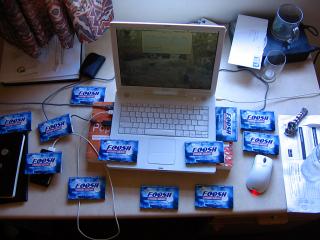The Luminox festival is really quite something. Essentially a celebration of combustion, it runs all along Broad Street from 7:00pm to 10:00pm for the next two days. The event involves a combination of fire-based artistic displays and live music. The whole thing seems to be paraffin powered, and it includes both static displays and manned installations that are made to flare up with the removal of chokes. Spaced along the road are braziers of coal and wax-burning metal chimneys that glow orange hot. Hanging from a crane beside Balliol College is a massive chandelier of flame.
Having such an immediate experience with fire would be impossible in lawsuit-happy North America, but it is quite engaging and beautiful. I actually took about fifty pictures, so expect to see them crop up on future days when I am too busy to find something new.
PS. Today, I also saw the inside of the Green College tower tonight, and got a photo of Mansfield for my growing collection of Oxford college images.
PPS. Did you know that you can set Google Calendar to automatically notify you of upcoming appointments by SMS? During the breaks, I have trouble keeping track of exactly which generally unstructured day I have an event in. With this free service, I have a very helpful aide memoire.

